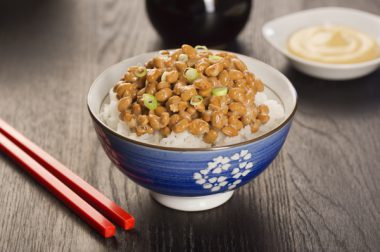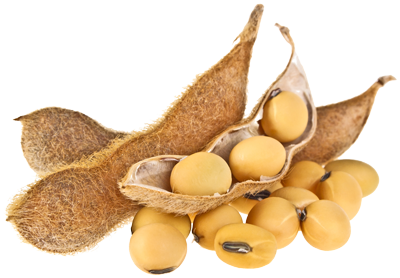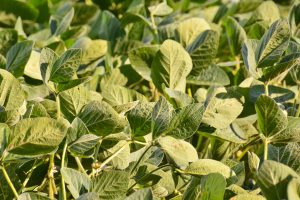Recipes we love
See all recipesHarlequin Salad soya, beetroot, carrot
Why not mix cooked and raw vegetables? The combination of crunchy and tender textures is also a grea...
Lentil salad with smoked bacon
A traditional, savoury recipe to share with friends or family. A recipe full of fibres that help the...
Bean-tuna sandwich
A recipe to share with friends or family that help digestion and provide vitamin B9 which contribute...
Health benefits
A good meat alternative
Soybeans are the only pulse with a well-balanced protein composition (all essential amino acids are present). With its complex carbohydrate. content, soy provides energy. Free of lactose and cholesterol, soy contains unsaturated fatty acids but is low in saturated fatty acids. All of this makes it an excellent substitute if you want to eat less meat or if you are vegetarian.
Soy is also:
- a source of vitamin B9 (for cellular renewal, particularly important for pregnant women forfetal development, for growing children, and for convalescents).
- a source of vitamin B1 (heart function, energy, nervous system)
It also contains:
- de la vitamin C
- du iron
- du zinc
- du calcium
- des isoflavones, antioxidant compounds that are currently a major research focus in the fight against cancer, cardiovascular diseases, osteoporosis, and menopause symptoms.
Did you know? Though all pulses contain isoflavones, soybeans contain the most.
Nutritional composition
When is the right
time to eat it?
All year.
Soy is available year-round, but soybeans are harvested at the end of the year.
Vegetable patch or urban balcony?
Soybeans (Raphanus sativus,, of the Papilionaceae family) are climbing annuals that grow well in sandy, well-drained soil rich in humus, in full sun.
To learn everything you need to know about growing soybeans, read the page on growing advice.
Choosing and
storing soy
Choose your soybeans well:
- The beans should be smooth and intact.
- The color should be bright and the size uniform.
- They should not have sprouted!
Properly store your soy:
- Store dry beans, soy sauce, and miso for 12 months in a cool, dry place.
- Store soy milk, tofu, natto, and tempeh for one to two weeks in the refrigerator.
Tips and tricks
How to prepare soy
Except in Japan, soy is rarely eaten fresh or dried. It is most often prepared in the form of several soy derivatives.
Soybean juice (tonyu, also called soy milk) comes from beans that are ground while hot to extract a liquid that resembles milk. It is used to produce dairy product alternatives, such as flavored drinks and alternatives to yogurt and cream. It can be cooked in the same way as dairy products.
Tofu is “curdled” soy milk.
Miso is obtained by pureeing soybeans, then fermenting them for several months. It is an essential ingredient in Japanese cuisine.
Soy sauce (shoyu or tamari) is made up of soybeans that are first fermented, then brined.
Natto is soy cooked with a specific bacteria. After a few days, it begins to resemble blue cheese, with a soft, stretchy, mozzarella-like texture.
A similar procedure is used to make tempeh, except a different bacteria is used and fermentation is limited to 24 hours.
Soy goes well with…
Tofu is delicious in soups, salads, and stir fries. It can be grilled and fried.
Miso is usually eaten in seaweed-based broths, or in a sauce served with vegetables or tofu.
Soy sauce is a perfect accompaniment for sushi, sashimi, daikon (a type of radish), and cabbage salads. It can also be used to season many different sauces and vinaigrettes.
Natto is eaten with rice, tofu, tempura, or omelets.
Tempeh is used as a meat substitute (ground, in sausage form, etc.). It can be sautéed, steamed, or marinated.
Can everyone eat it?

People who are allergic to milk proteins often eat soy-based foods. But be careful—soy can also cause allergies.
Young children
In France, the national agency of food safety (ANSES) recommends waiting until age 3 to consume soy drinks. These drinks should not replace milk and follow-on formula for babies. The same is true for soy-based foods (tofu and all sauces).
If children are at risk for allergies and their mother does not want to nurse them, hypo-allergenic milk, marked “HA” in France, is the recommended solution.
And everyone else…
In France, the national agency of food safety (ANSES) recommend limiting consumption of soy-based foods and drinks (and even dietary supplements) to avoid going over the limit of 1 mg isoflavones/kg of body weight (phytoestrogen is contained in soy).
See plenty of other tips for encouraging children to eat vegetables
Where does it come from?
Origins and varieties
Origins
Soy is mainly produced in the United States, Brazil, Argentina, China, Romania, and Russia.
Varieties
There are different kinds of soybeans:
- Green soybeans (Glycine maxima), found especially in Asia: This round, small, nearly oilless bean, eaten in the form of broths, purees, soups, and sprouts, can be consumed raw or blanched, in salads or cooked (in Chinese cuisine). Their starch is used to make Chinese noodles, which are low in oil.
- Yellow soybeans (Glycine maxima), found especially in the United States: These soybeans, after trituration, are broken down into 18% oil (to eat cold with raw vegetables) and proteins (38% to 40% of the dry matter), used in cattle cake, soy derivatives (tofu, tempeh, miso, etc.), or high-protein diet products.
Did you know? Average soy consumption in China is around .35 ounces (around two tablespoons) per day, per person, a much higher quantity than what an American or a European eats. In certain areas of Japan, that number reaches around 2.1 ounces! In Asia, soy is eaten in small quantities as a condiment, not as an animal protein replacement.



 Carott
Carott  Artichoke
Artichoke  Vegetable garden: growing fennel
Vegetable garden: growing fennel 










